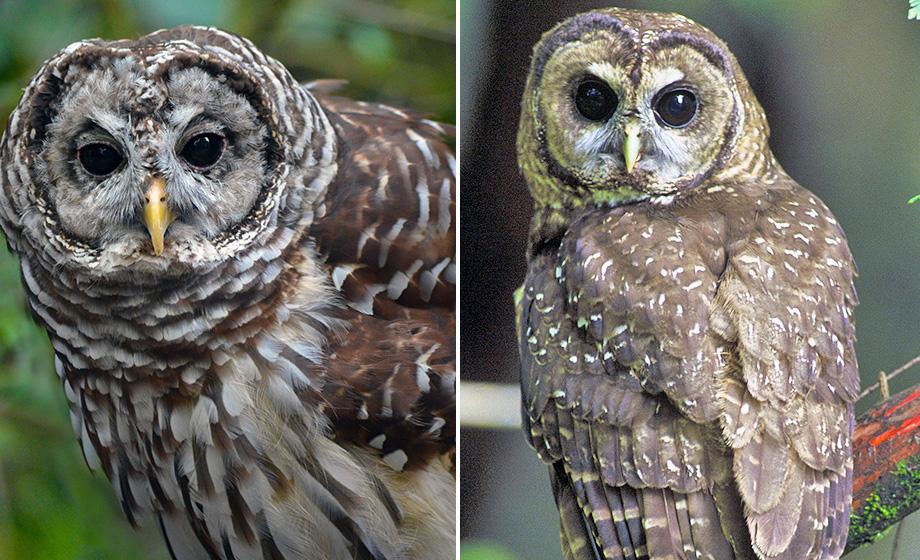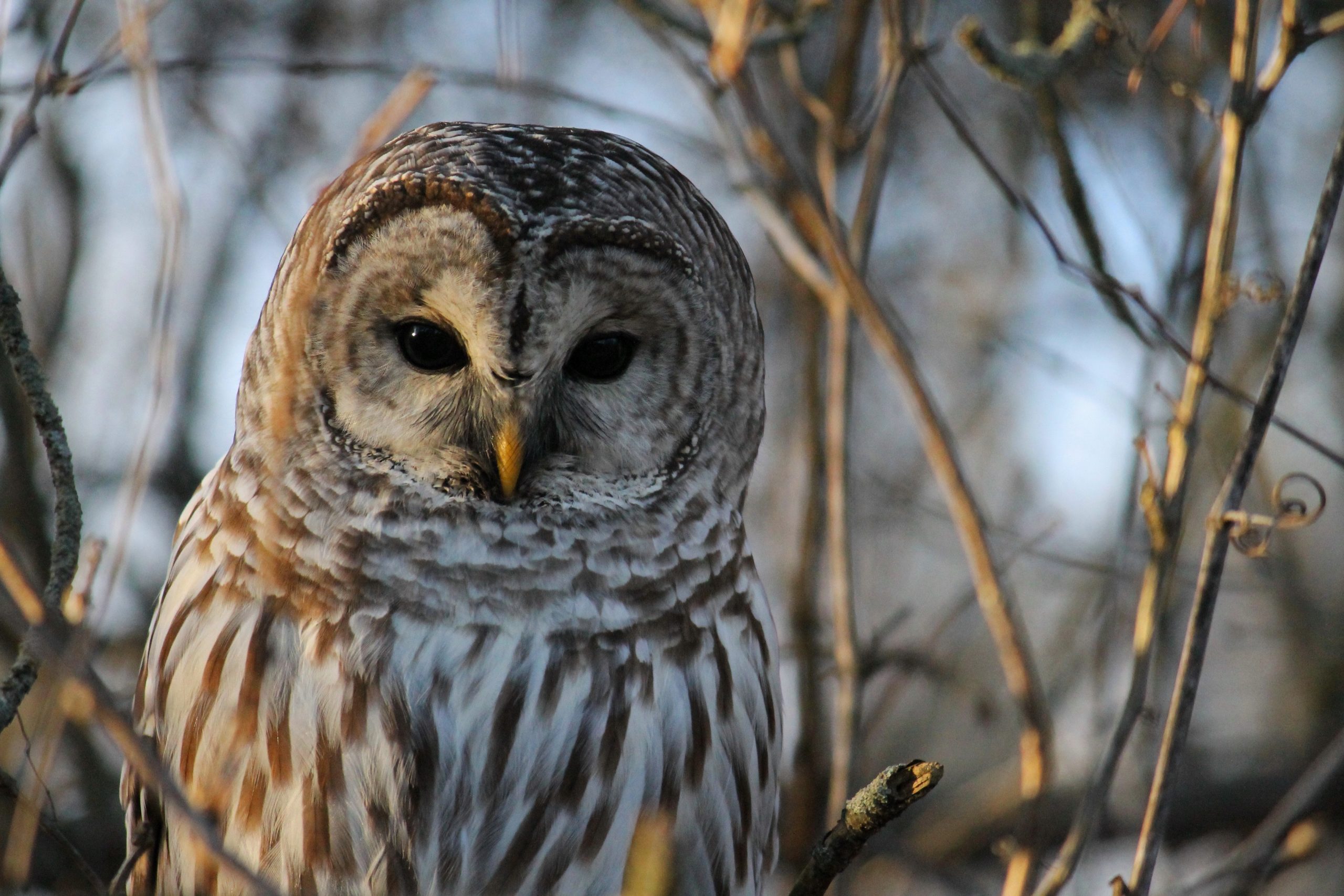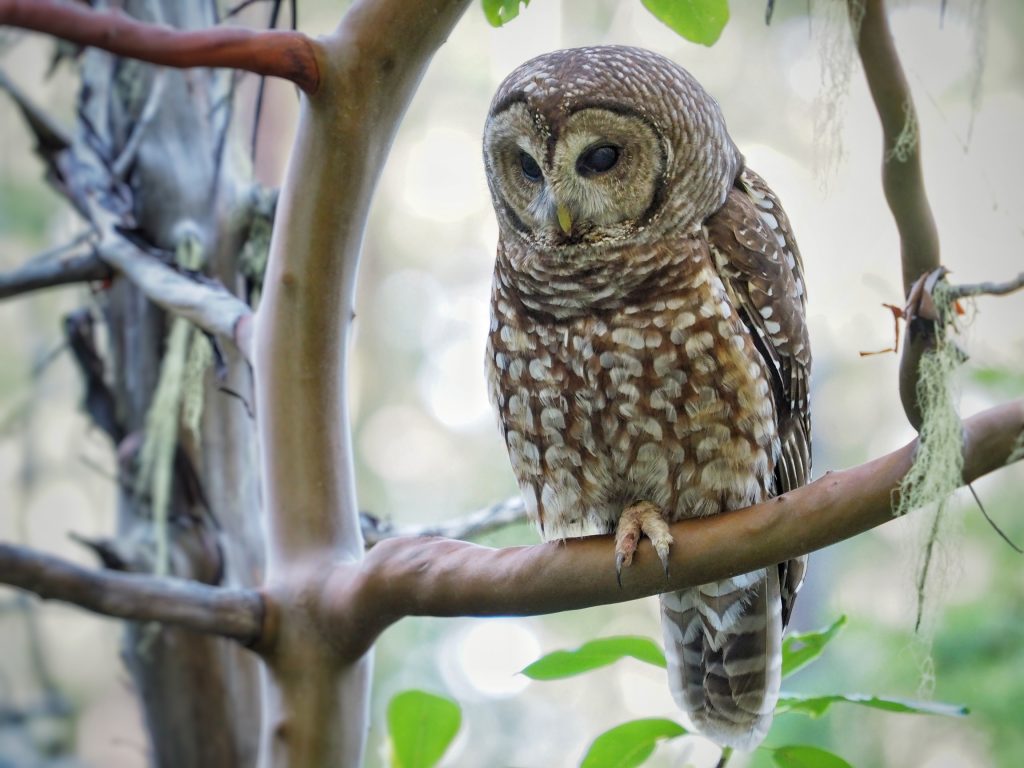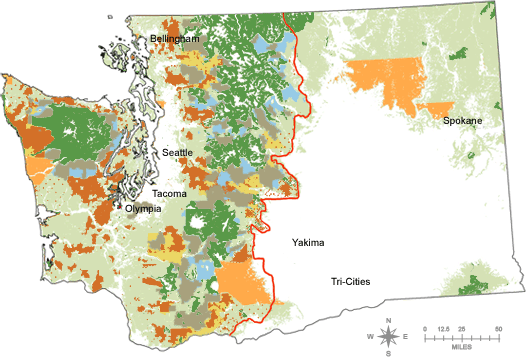WASHINGTON FOREST PROTECTION ASSOCIATION
Northern Spotted Owl
The foundation of the recovery strategy for the Northern Spotted Owl is a network of owl conservation areas located on Federal lands, complemented by state, private and tribal lands. Use this interactive map to learn about the conservation efforts of the Northern Spotted Owl in Washington State and how landowners have been actively developing management plans to help conserve the Northern Spotted Owl. This special feature shows who manages the forestlands, where the spotted owls live, and how the spotted owls are protected across the landscape.
NORTHERN SPOTTED OWL LISTED AS “THREATENED” UNDER THE ENDANGERED SPECIES ACT – PRESIDENTIAL ACTION TAKEN

Barred Owl (Strix varia) on left and Northern Spotted Owl (Strix occidentalis caurina) on right
The Northern Spotted Owl was listed as “threatened” under the Endangered Species Act in 1990 due to over-harvesting of old growth habitat, and lack of regulations to stop the decline. On April 13, 1994, the Federal government adopted President Clinton’s Northwest Forest Plan (NWFP) as a strategy to recovery the owl, which sought to conserve the species on 24.5 million acres of Federal lands over 100 years’ time. The NW Forest Plan is not a “stand-alone” management plan. It amended 26 land and resource management plans (LRMPs) of the U.S. Forest Service and Bureau of Land Management (BLM), marking the first time that the Forest Service and BLM have worked together to preserve ecosystems across their boundaries. The NW Forest Plan developed a forest management strategy to protect more than 1,000 late-successional and old-growth dependent species across 19 National Forests and 7 Bureau of Land Management Districts throughout the three state range of the owl in Washington, Oregon and California. The NWFP established a system of late-successional forest and riparian reserves that would, in conjunction with Administratively withdrawn and Congressionally reserved areas, provide the foundation of protected “old growth” habitat that would benefit spotted owls, marbled murrelets, salmon and many other old growth associated species. Future timber harvesting activities on Federal lands within the range of the northern spotted owl were expected to occur primarily in Adaptive Management Areas and Federal lands determined to constitute the “matrix.” Scientists thought it could take up to 50 years to recover the owl.
IMPLEMENTING PRESIDENT CLINTON’S NW FOREST PLAN
The Northwest Forest Plan has been working at slowing the “precipitous decline” of the spotted owl. The Wildlife Society states that this strongly suggests that the recovery plan should continue to be based on the NWFP. The #1 success of the Northwest Forest Plan is protection of old growth habitat. In the first ten years of the plan, older forest on federally managed land appears to have met or exceeded the Northwest Forest Plan expectations of growing 600,000 acres per decade. In the first ten years of the plan, older forest grew twice the rate, at 1.2-1.5 million acres, outpacing losses from all sources. Since 1994, federal timber harvest levels have been reduced 98% in Washington State and 80% across the three-state range.
On the other hand, the NWFP has not been fully implemented as it was envisioned. Lack of active management in the adaptive management areas has caused serious setbacks in learning about the spotted owl’s use of prey and barred owl-spotted owl interactions. The plan reduced harvest levels by 80% and only a third of the new harvest level has ever been achieved. This resulted in a range-wide harvest reduction of 94%. Other factors that have increased the risk to spotted owl recovery include, lack of active management of fire-frequent, insect prone sites proscribed by the NWFP. Scientific review has shown that failure to fully implement the Northwest Forest Plan on federal lands has increased the risk to spotted owl recovery.
The Barred Owl Is A Significantly Greater Threat To The Spotted Owl Than Was Envisioned When The Owl Was Listed In 1990.
While close cousins, one of the differences between the Barred Owl and Northern Spotted Owl are the number of notes in their calls. The barred owl typically has an 8-note hoot, and Northern Spotted Owl, has a 4-note hoot. If they breed, the Sparred Owl (Barred Owl / Spotted Owl hybrid) has a distinctive 5-6 note hoot.
 Recently, scientists say the larger and more aggressive Barred Owl is the most important threat currently facing the Northern Spotted Owl. The range of the Barred Owl now completely overlaps and extends beyond that of the Northern Spotted Owl. The presence of the Barred Owl negatively affects the spotted owl by competing for prey and habitat. Significant effects on reproduction, survival, displacement from nest sites, and the likelihood that spotted owls will not call or hoot during standard survey methods, is making it difficult to detect whether spotted owls are actually there. In the Olympic National Park, barred owls have taken over nearly two-thirds of the spotted owl sites. The Barred Owl range and numbers are expanding rapidly, moving west from the eastern United States, through Canada, and now into the Pacific Northwest. This cousin species lives in similar types of habitat as the spotted owl and eats the same type of prey. Barred Owls are also less susceptible to diseases such as West Nile Virus, and have been known to attack the spotted owl. The USFWS is now conducting sophisticated modeling to analyze various habitat networks across the range, including the barred owl impact. Early modeling results show the spotted owl will not recovery in 10 of the 11 modeling areas without addressing the barred owl invasion, despite the amount of habitat set aside. The USFWS acknowledges that securing habitat alone will not recover the spotted owl and the barred owl threat requires immediate action.
Recently, scientists say the larger and more aggressive Barred Owl is the most important threat currently facing the Northern Spotted Owl. The range of the Barred Owl now completely overlaps and extends beyond that of the Northern Spotted Owl. The presence of the Barred Owl negatively affects the spotted owl by competing for prey and habitat. Significant effects on reproduction, survival, displacement from nest sites, and the likelihood that spotted owls will not call or hoot during standard survey methods, is making it difficult to detect whether spotted owls are actually there. In the Olympic National Park, barred owls have taken over nearly two-thirds of the spotted owl sites. The Barred Owl range and numbers are expanding rapidly, moving west from the eastern United States, through Canada, and now into the Pacific Northwest. This cousin species lives in similar types of habitat as the spotted owl and eats the same type of prey. Barred Owls are also less susceptible to diseases such as West Nile Virus, and have been known to attack the spotted owl. The USFWS is now conducting sophisticated modeling to analyze various habitat networks across the range, including the barred owl impact. Early modeling results show the spotted owl will not recovery in 10 of the 11 modeling areas without addressing the barred owl invasion, despite the amount of habitat set aside. The USFWS acknowledges that securing habitat alone will not recover the spotted owl and the barred owl threat requires immediate action.
When Barred Owls (Strix varia) and Spotted Owls (Strix occidentalis) meet, they sometimes hybridise, producing 'Sparred Owls'.

At first glance, the hybrid resembles both the spotted owl, a threatened species that primarily inhabits older forests of the Northwest, and the barred owl, a cousin common to much of North America.
On closer inspection, however, the sparred owl exhibits physical markings, calls and other characteristics that combine the traits of the two parent species.
‘The tail feathers are like a barred owl and the breast feathers are like a spotted owl. The characteristics are intermediate,’ said Eric Forsman, a research biologist for the U.S. Forest Service in Corvallis, Ore.
Both hybrids were males found roosting with female barred owls. The first, originally thought to be a spotted owl, was identified as a cross-breed last month near Mount Baker in the northern Cascades range of Washington. (Information from UPI) (image from: Photograph of a Sparred Owl on the Shasta-Trinity NF taken by William Thein)
WASHINGTON STEPS UP EFFORTS TO CONSERVE SPOTTED OWLS
Every individual owl is protected from harm under the Endangered Species Act.
Federal lands play the primary role in achieving recovery of the spotted owl. The NW Forest Plan serves as the basis for federal forest management. The NWFP explicitly acknowledges that nonfederal lands are not guided by the Plan’s federal standard and guidelines, it encourages agencies to work with nonfederal landowners to seek voluntary contributions to owl conservation through mechanisms such as Habitat Conservation Plans, 4(d) Rules, and Safe Harbor agreements. Washington State’s comprehensive forest practices regulations complement the federal vision for recovery of the spotted owl, implementing a rule developed in collaboration with environmental groups, federal, state and county officials, and forest landowners. In fact, the state’s forest practices rules far exceed the federal expectations for nonfederal contribution to owl conservation. See how spotted owls are protected in the interactive map of Washington State.
WASHINGTON STATE COLLABORATIVE GROUP DEVELOPS CONSENSUS ACTIONS TO ADDRESS NORTHERN SPOTTED OWL CONSERVATION
A unique alliance of environmental groups, small and large forest landowners, county, state and federal officials, met for a year during 2009. The goal was to develop a new paradigm for owl conservation, focusing on voluntary, incentive-based measures to attract additional non-federal contributions. The goal is to enhance federal recovery of the owl with strategic contributions from non-federal lands. In Washington State alone, non-federal lands currently contribute more than 3.7 million acres of land to owl conservation, but new scientific modeling is helping to update old assumptions that simply setting aside large blocks of owl habitat is the main solution to recovery. New studies, and telemetry research is showing that other factors such as reducing barred owl risk, addressing unhealthy fire-prone forests, improving the abundance of prey and active management plays an increasingly important role for owl conservation. The group presented their final report to the State Forest Practices Board on February 10, 2010. The recommendations are being implemented now through the Board’s Northern Spotted Owl Implementation Team.
